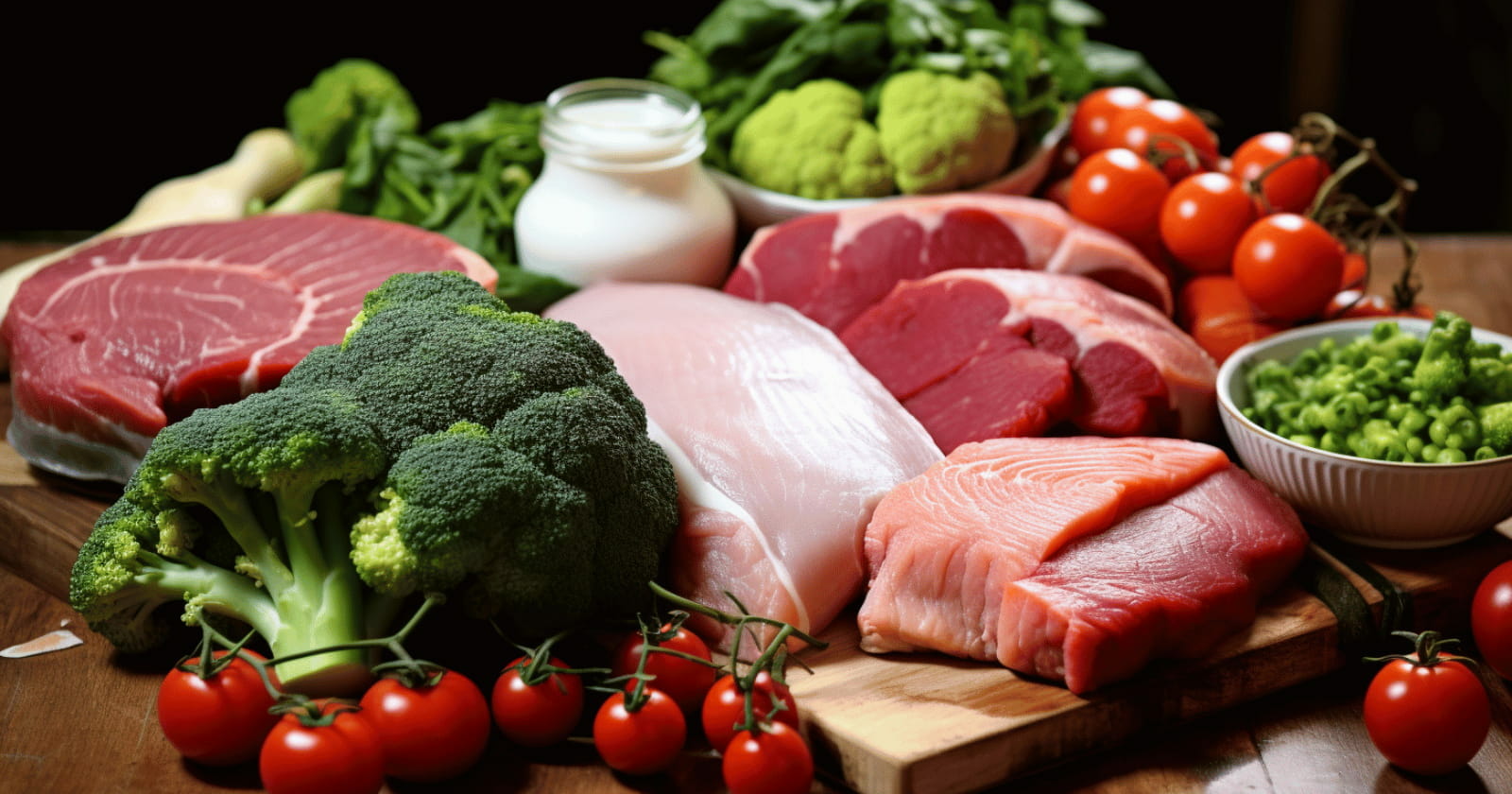Looking to boost your NAD levels naturally? While NAD itself isn’t found in foods, certain nutrient-rich options contain NAD precursors that support our bodies’ NAD production. Top food sources of NAD precursors include meat, fish, and some plant-based foods.

Key Takeaways:
-
- NAD isn’t directly found in foods. However, foods containing NAD precursors can help our bodies generate NAD.
-
- Animal-based foods like beef liver, chicken, turkey breast, and salmon contain the NAD precursor niacin.
-
- NMN-rich foods like tomatoes, edamame, and broccoli help support NAD production.
-
- Plant-based foods like legumes and grains contain less niacin per serving.
-
- Foods containing tryptophan, such as turkey, chicken, and milk, can also help with NAD generation.
It’s no wonder researchers and health enthusiasts have been looking for natural ways to increase the body’s NAD (nicotinamide adenine dinucleotide) levels. After all, NAD plays a crucial role in numerous processes.
Beyond boosting energy, NAD may be beneficial in helping to promote healthy aging, improve cognitive function, and protect against heart disease.
It turns out the key to unlocking higher NAD levels might already be hiding in our daily meals. Keep reading to learn more about the food sources that can boost your NAD levels.
NAD+ and NADH are two versions of the same molecule. NAD+ is the oxidized form, while NADH is the reduced form. Throughout this article, we’ll refer to it as NAD.
Is NAD Found in Foods?
No, NAD the molecule is not found directly in foods, but NAD precursors are found naturally in foods.
The cells in our bodies need certain building blocks, known as NAD precursors, to generate NAD. After they enter our bodies, these precursors undergo chemical changes in the cell to form NAD.
These precursors include nicotinamide mononucleotide (NMN) and tryptophan. Niacin, also called vitamin B3, is a well-known NAD precursor. Niacin comes in different forms like nicotinic acid (NA), nicotinamide (NAM), and nicotinamide riboside (NR).
What Foods Contain NAD Precursors?
-
- The list provided is not exhaustive, and there are other foods that contain NAD precursors.
-
- The amount of NAD precursors in foods can vary depending on the cooking method and other factors.
-
- The values mentioned in the table are general estimates and may vary in specific food items.
The table below lists foods that contain NAD precursors.
| Food Sources | Precursor | Content | Additional nutritional value |
| Beef liver
Raw beef |
Niacin
NMN |
14.9 mg per 3 ounces 0.06–0.42 mg per 100 g |
Rich in iron, vitamin B12, and zinc. |
| Chicken | Niacin | 10.3 mg per 3 ounces | Promotes healthy muscles and is an excellent source of protein. |
| Turkey breast | Niacin
Tryptophan |
10 mg per 3 ounces
244 mg per 3 ounces |
Rich in protein, vitamin B6, vitamin B12, and zinc. |
| Salmon orTuna | Niacin | 8.6 mg per 3 ounces | Good source of omega-3 fatty acids, which help maintain a healthy heart. |
| Rice (brown)
Rice (white) |
Niacin | 5.2 mg per cup
2.3 mg per cup |
Rich in essential vitamins and minerals. Brown rice is a good source of fiber. |
| Tomatoes | Niacin
NMN |
0.5 mg per half a cup
0.26–1.60 mg per 100 g |
Good source of antioxidants, vitamin C, and riboflavin.
|
| Edamame | Niacin
NMN |
0.7 mg per half a cup 0.25–1.88 per 100 g |
Excellent source of protein, fiber, vitamins, and minerals. |
| Broccoli | Niacin
NMN |
0.4 mg per half a cup
0.25–1.88 mg per 100 g |
High in vitamin C, vitamin K, iron, potassium, and fiber. |
| Milk | Niacin
Tryptophan |
0.2 mg per cup
107 mg per cup |
Good source of calcium, protein, riboflavin, and zinc. |
-
- Beef: About 3 ounces of pan-fried beef liver contains 14.9 mg of niacin. This represents 93% of the daily value of niacin. In addition to being an excellent source of niacin, beef liver is also rich in iron, vitamin B12, and zinc. In a 3-ounce serving of pan-browned ground beef that is 90% lean, there are 5.8 mg of niacin. Raw beef contains a small amount of NMN, ranging from 0.06 to 0.42 mg per 100 grams.
-
- Chicken: Consuming 3 ounces of grilled chicken breast can give you about 10.3 mg of niacin. That’s equivalent to 5.25 mg of niacin in just one drumstick. Aside from its niacin content, chicken is a good choice for promoting healthy muscles and overall well-being due to its high protein content.
-
- Turkey: A serving of turkey breast weighing 3 ounces offers 10 mg of niacin and 244 mg of tryptophan. Alongside its niacin content, turkey breast is an excellent source of protein, vitamin B6, vitamin B12, and zinc.
-
- Fish: Sockeye salmon (about 3 ounces cooked) or tuna (canned in water, drained, about 3 ounces) provide 8.6 mg of niacin. Additionally, fish is known for its omega-3 fatty acids content, which helps promote heart health.
-
- Rice: Both brown and white rice are staple foods that provide important nutrients to our diet. A 1-cup serving of cooked brown rice contains 5.2 mg of niacin, while the same amount of cooked white rice provides 2.3 mg of niacin. In addition to niacin, brown rice is rich in essential vitamins and minerals and is mainly known for its higher fiber content compared to white rice.
-
- Tomatoes: They are a tasty and nutritious addition to meals. Half a cup of cherry tomatoes provides approximately 0.5 mg of niacin. Tomatoes also contain NMN in amounts ranging from 0.26 mg to 1.60 mg per 100 grams. Moreover, tomatoes are a good source of antioxidants, vitamin C, and riboflavin.
-
- Edamame: With 0.7 mg of niacin per half a cup, frozen and prepared, edamame can contribute to niacin intake. Edamame also contains NMN with a content ranging from 0.47 mg to 1.88 mg per 100 grams. It’s also an excellent protein, fiber, vitamins, and minerals source.
-
- Broccoli: Broccoli is rich in essential nutrients like vitamin C, vitamin K, iron, potassium, and fiber. It also contains niacin at 0.4 mg per half a cup when boiled, drained, and chopped. Additionally, its NMN content ranges from 0.25 to 1.88 mg per 100 grams.
-
- Milk: One cup of milk containing 1% fat can provide 0.2 mg of niacin per serving. This represents 1% of the daily value of niacin. One cup of whole milk contains about 107 mg of tryptophan. Cow milk has about 12 micromoles of NAD precursor vitamins per liter. Of this, 60% is nicotinamide, and 40% is NR. Milk also contains protein, calcium, zinc, and riboflavin and is beneficial for bone health and preventing osteoporosis in adults.
Is Eating Foods High in NAD Enough to Replenish NAD?
Eating foods high in NAD precursors can support the body’s natural production of NAD, but it might not be sufficient to replenish NAD levels fully.
The effectiveness of NAD production from these precursors can vary based on individual factors such as age, genetics, and overall health. Additionally, our bodies’ ability to convert these precursors into NAD may differ from person to person.
To maximize the benefits of NAD, adopt a holistic approach to health. In addition to incorporating NAD-rich foods into your diet, maintaining a balanced and varied eating plan can provide a wide range of nutrients that support overall well-being. Regular physical activity and adequate sleep also play vital roles in supporting NAD production.
Why Is NAD Good For You?
NAD is good for you because it plays a vital role in various processes within our cells.
One of its primary functions is to help convert food into energy. This energy is essential for our daily activities, from simple tasks like walking to more complex functions like thinking and breathing.
NAD also serves as a critical component in DNA repair, helping to fix damaged DNA and maintain the integrity of our genetic information.
The levels of NAD in our bodies tend to decrease as we age. can lead to reduced energy production and increased vulnerability to age-related health problems. Maintaining adequate NAD levels may support healthy aging, boost cognitive function, and protect against certain heart diseases.
FAQs:
NAD vs. NMN: What’s the difference?
Are NAD supplements worth it?
What happens when NAD converts to NADH?
Which NAD supplement is best?
Can NAD help you lose weight?
Final Thoughts
To maximize NAD’s benefits, consider adding foods rich in NAD precursors to your meals daily. A balanced diet with a mix of these precursors can keep your NAD levels optimal. Also, living a healthy lifestyle, with exercise and good sleep, helps your body produce more NAD.
Related: What is the Optimal NAD Dosage?
Talk to a healthcare provider before making any dietary changes or taking supplements. They can help you understand what’s best for your health and make informed choices.
Resources
-
- Mills et al. 2016. Long-Term Administration of Nicotinamide Mononucleotide Mitigates Age-Associated Physiological Decline in Mice.
- National Chicken Council. 2021. Nutrition & Health.
- National Institutes of Health. 2022. Niacin.
- Poljsak et al. 2020. Healthy Lifestyle Recommendations: Do the Beneficial Effects Originate from NAD+ Amount at the Cellular Level?
- Shade, C. 2020. The Science Behind NMN–A Stable, Reliable NAD+Activator and Anti-Aging Molecule.
- Trammell et al. 2016. Nicotinamide Riboside Is a Major NAD+ Precursor Vitamin in Cow Milk.
- U.S. Department of Agriculture. 2019. Chicken.
- U.S. Department of Agriculture. 2019. Milk.
- U.S. Department of Agriculture. 2019. Turkey.
